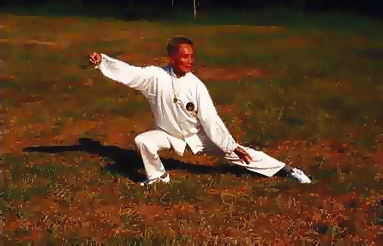Note: this is a primer for those attending my classes or members of my online membership; it does not cover everything but covers the basic concepts and theories of what I teach.
What is chi?
It is said that this invisible, internal energy flows throughout the body through energy channels (meridians) that feed into the various organs and link from points (acupuncture points) on the skin. When the energy stops flowing, we become ill and then die. And so we need to practice exercises that improve the flow of this energy, acquire clean (healing) energy and get rid of dirty (toxic) energy.
In my classes, although I sometimes mention certain channels and vessels, for a beginner, it’s more important to think about holistic health and improving this through chi kung exercises.
What is chi kung?
The direct translation is “energy work”. There are many different types of chi kung exercises. Some are more for general health maintenance and improvement while others are said to be very specific in their uses eg helping with certain cancers.
In the general access classes that I teach, the focus is on holistic health, and so these movements can help to improve your overall physical and mental health. Via the EAST Method, you can even use specific movements to deal with your mental health including states like fear, worry and limiting beliefs.
For each exercise, you will learn the specific movement, the breath technique and what to focus on in terms of visualising energy.
The mind leads the energy (the yi leads the chi) and so intention is important.
Additionally, simply performing these movements slowly will lead to a general feeling of calm and wellbeing.
What about the warm up exercises?
In additional to chi kung, I also lead a set of warm up exercises which incorporates joint loosening and light stretching.
The joint loosening helps with flexibility and mobility in the joints but also means that the chi does not stagnate in the joints.
The stretching makes it easier to perform both chi kung and tai chi movements.
What is tai chi?
Tai Chi was originally designed as a martial art – you can see punches, kicks and even throwing techniques performed slowly as if the practitioner is fighting slowly. Many people still study tai chi as a martial form but my class focus is on physical and mental health and wellbeing.
Performing the form slowly will improve your physical ability as well as help to make you feel calm.
It takes about 3 years to get through the forms that I teach in a class if you attend weekly. This doesn’t mean that you will necessarily remember it but you will be able to move with me with confidence as you will recognise the sequence as we go through it.
How to learn
I like to make things easy for beginners so:
-copy me the best you can
-remembering is optional
-attend regularly
-enjoy the flow, and don’t worry about making mistakes
Doing this makes it easy and not stressful to pick up the movements.
It’s like when you hear a new song on the radio. The first time you hear it, you may enjoy the song and think it’s got a catchy tune. Then over time when they play it every day, you start to pick up lyrics. And before you know it, you can sing the entire song on your own.
How to move in tai chi
Tai Chi is all about the efficient use of physics!
-learn to spiral up your force from the ground – the power starts in the feet, moves through the legs, then the hips then the torso, then the shoulders and then out through the hands. You can see this in play by watching a professional golfer, a boxer or a tennis player.
-the basis of all movements comes from stable postures; you can achieve this by relaxing the legs and not having your feet too close together. Think of how the Eiffel Tower looks like.
-when in a posture, at least one foot is generally flat on the floor.
-the body moves as one – if you turn left, everything tends to turn left; if you move forward, everything moves forward; in practical terms this means that if you are stepping backwards, you wouldn’t punch as your reversing will remove a lot of power from the punch!
Key stances
The following list details the general stances used in chi kung and tai chi, irrespective of what the hands are doing.
Meditation stance – mainly for chi kung, feet are shoulder width apart, feet pointing forwards, knees bent over the toes, knees bent, tailbone tucked under the pelvis (roll the bottom of the pelvic bone forward to straighten the low back), tuck the chin in slightly to straighten the spine.
Bow stance – feet are opposite corners of a square so it’s a really strong, stable stance, front knee bent, front foot facing forward, rear leg straight, rear foot pointing outwards 45 degrees. 70% of your weight is on the front foot. If your front foot is directly in front of your rear foot then it is far too narrow; practice being far too wide to get the feeling of openness in the pelvic area and a strong stance. Think about how a wrestler would stand.
Cat stance – this is a back foot-biased stance so 90% of your weight is on the rear foot. The rear foot points outwards 45 degrees. The rear knee is bent over the toes and points in the direction of the toes. The front foot rests softly on the ball of the foot so that the heel is off the ground; the front knee is bent. A variation of this has the front heel touching the ground and the toes are off the ground. In this stance, you can quickly kick with the front foot without having to transfer weight off the front foot by rocking backwards.
What’s the minimum physical fitness required for practising tai chi and chi kung?
Ideally, if you can carry two bags of shopping across a car park, that’s good enough for my classes. However, you can still get a lot of benefit by practising while sitting down if you are unable to stand.
Additionally, you can also practice the movements even if you need a walking stick or frame – just have it close to hand or have a chair close by. Make the practice work for you and don’t compare yourself to others. Over time, the benefits will appear. Also think about your safety so you don’t fall.
I’ve seen students initially requiring their walking frame in front of them while they practice but over time, I notice that they leave their frame in the corner of the room!
Who can benefit from these practices?
Everyone can benefit; it’s just that they don’t realise it. I’ve practiced tai chi and chi kung since first learning it in the 1980s as a teenager. Here is a big list of benefits which will give you an idea of who tai chi and chi kung can benefit: https://www.wimble.com/breathing-just-isnt-for-me/
A note about cancer and chi kung
Someone asked for further info about the role chi kung can play when dealing with cancer. Here’s my reply:
It’s not something I’ve focused on because I haven’t seen any decent studies outside China but have a look at the work by Mantak Chia and see where that leads you.
The thing to remember is that, looking at the theory of it all, if cancer is caused by imbalances and blockages of chi, according to TCM, then general holistic chi kung exercises may help. In any case, they will help to reduce stress and anxiety which can cause cancer so by taking away the environment within which cancer thrives, the body should correct itself.
Note that everyday the body is fighting cancerous cells before they take hold. It’s only when our immune system drops that cancer can set in. And so, practising general holistic chi kung can help to reduce the risk of cancer.
Whatever the case, I’d recommend speaking to your GP every time and use complementary therapies as a support plan.
This actually applies to any illness or disease. Your body is naturally trying to heal itself and if your energy system isn’t well, then your body won’t be well. The same applies for your immune system and generally not being well due to a poor immunity. And so, general chi kung that I teach may help.

